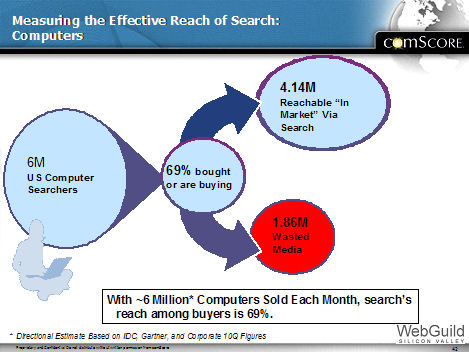In my most recent interview with James Lamberti of comScore we talked about the future of search – with a particular focus on how search would become more tightly integrated with traditional marketing. This could mean a large uptick in dollars being invested in search.
One of the big problems is that traditional marketers have evolved sophisticated ways of talking about, thinking about, and measuring the results of their campaigns. They focus on terms such as reach, awareness, purchase intent, and likelihood to recommend.
Reach is one of the critical metrics in that list. When a traditional marketer runs a TV advertising campaign they may succeed at putting their message in front of tens of millions of viewers. The marketer knows how much money they spent, and have a workable estimate as to the number of people they have reached with their message.
Search marketers focus on direct response type metrics, particularly in pay per click (PPC) marketing campaigns. Their main concerns usually are focused on the direct and immediate impact of a PPC campaign. I.e., if they spent $1000 on PPC yesterday, how many sales were generated on the website as a direct result of the PPC campaigns yesterday?
The beauty of the search marketer’s model is that it provides a very direct measurement of results. Better still, well-crafted campaigns can sometimes offer extraordinary ROI, but there are still two problems with the direct response model:
- It is not the model used by traditional marketers. This truly is a big problem. By not speaking their language, the search marketer sets themselves up for failure in a traditional marketing environment.
- The current budget spend on search is simply not significant. It might represent a fraction of a percent of a major brands budget. Even if the ROI is five times higher than the ROI on the other advertising vehicles used by the CMO, search only ends up solving a very small piece of the CMO’s marketing problem. Effectively speaking, it’s not on the radar.
However, this is evolving fast. It was illustrated beautifully by James in his presentation at the Searchnomics conference last year and during our interview. Let’s start with a slide from James Searchnomics deck:
 |
According to the comScore data, search’s reach was 69% of all people who bought computers within a given month (4.1M reached out of 6M buyers). Correspondingly, a TV campaign that placed in ads in front of 40 million viewers might reach only 500,000 buyers.
Now in my example above, I have twisted the language a little bit. I have moved the focus to reach people who end up buying. This subtle tweak is at the heart of how search differs from traditional advertising. Search provides control on who you reach, so you can focus your message on people who have already indicated an interest in what you are offering.
Put another way, traditional media has a major component of trying to create the desire to buy. Search is about communicating with those who already have the desire. For years, this is the way I have put it: “Search is not about trying to find customers. It’s about enabling people who want a product like yours to find you.” With search, people have already declared their motivation, you are just capitalizing on it.
Ultimately, search marketers need to learn to manage these subtleties and communicate about them effectively with traditional marketers. Using a metric such as reach, and adapting it to clarify the advantages that search offers will be a big step in this direction.
